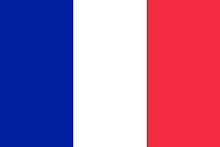terça-feira, 7 de outubro de 2008
Sports

Popular sports include football, both codes of rugby football and in certain regions basketball and handball. France has hosted events such as the 1938 and 1998 FIFA World Cups, and hosted the 2007 Rugby Union World Cup. Stade de France in Paris is the largest stadium in France and was the venue for the 1998 FIFA World Cup final, and hosted the 2007 Rugby World Cup final in October 2007. France also hosts the annual Tour de France, the most famous road bicycle race in the world. France is also famous for its 24 Hours of Le Mans sports car endurance race held in the Sarthe department. Several major tennis tournaments take place in France, including the Paris Masters and the French Open, one of the four Grand Slam tournaments.
Religion and Culture

Religion:
The religion in france is divided with big diversity and how we can see the graphic the predominance is the Christianity.
Culture:
The culture of France and of the French people has been shaped by its geography, by profound historical events, and by foreign and internal forces and groups. France, and in particular Paris, has played an important role as a center of high culture and of decorative arts since the seventeenth century, first in Europe, and from the nineteenth century on, world wide. From the late nineteenth century, France has also played an important role in modern art, cinema, fashion and cuisine. The importance of French culture has waned and waxed over the centuries, depending on its economic, political and military importance. French culture today is marked both by great regional and socioeconomic differences and by strong unifying tendencies.
Demography

With an estimated population of 64.5 million people, France is the 19th most populous country in the world. France's largest cities are Paris, Marseille, Lyon, Lille, Toulouse, Nice, and Nantes.
France is divided into 26 administrative regions. 22 are in metropolitan France, and four are overseas regions. The regions are further subdivided into 100 departments which are numbered (mainly alphabetically). This number is used in postal codes and vehicle number plates amongst others. Four of these departments are found in the overseas regions and are simultaneously overseas regions and overseas departments and are an integral part of France (and the European Union) and thus enjoy a status similar to metropolitan departments.
Tourism in France

Paris, the capital city, attracts tourists with museums such as the Louvre and Musée d'Orsay, and attractions like the Eiffel Tower, Arc de Triomphe, the cathedral of Notre-Dame, the Disneyland Paris.
In the eastern parts of France there are skiing resorts in the Alps. Notable French cities are Avignon with the Popes' palace, Arles, Aix-en-Provence, Marseille, Nice, Orléans, Saint-Benoît-du-Sault on the Loire River, Toulouse on the Garonne, Strasbourg on the border with Germany, Nantes and Lyon, all over France rental accommodations and hotels are available.
France's Mediterranean beaches on the French Riviera, in Languedoc-Roussillon, or in Corsica, are famous. Away from the mainland tourists are French Polynesia (especially Tahiti), the Caribbean islands Martinique, Guadeloupe and others, the best time to go to france is in summer or winter because the beachs in the summers and the skiing resort in the winters.
The best place to eat in Paris is the Taillevent offers some of the best in fine dining, specializing in old-fashioned, classic haute cuisine. Opened in 1946 by André Vrinat, Taillevent is now run by his son, Jean Claude.
Geography - Continent, Hemisphere and Climate

France is situated between 41° and 51° North, on the western edge of Europe, and thus lies within the northern temperate zone. The north and northwest have a temperate climate, while a combination of maritime influences, latitude and altitude produce a varied climate in the rest of France. In the south-east a Mediterranean climate prevails. In the west, the climate is predominantly oceanic with a high level of rainfall, mild winters and cool to warm summers. Inland the climate becomes more continental with hot, stormy summers, colder winters and less rain. The climate of the Alps and other mountainous regions is mainly alpine, with the number of days with temperatures below freezing over 150 per year and snow cover lasting for up to six months.
Assinar:
Postagens (Atom)
